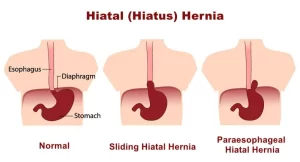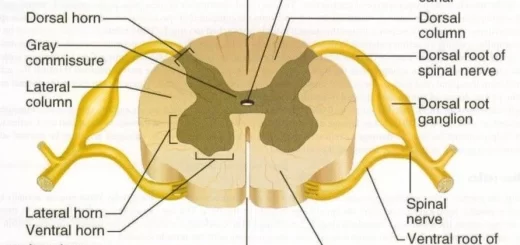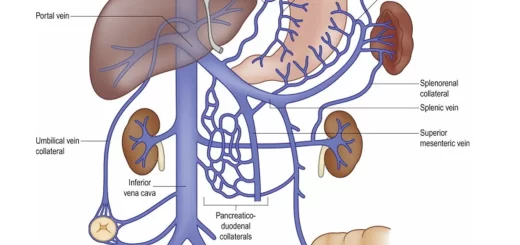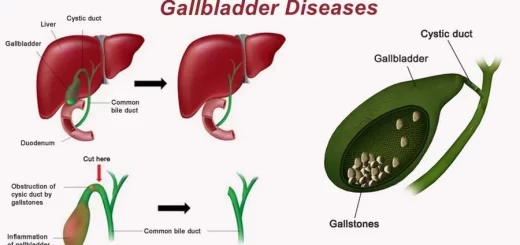Hiatus Hernia symptoms, Is a hiatus hernia serious?, Can hiatal hernia be cured?
Hiatus Hernia is the “protrusion (or herniation) of the upper part of the stomach into the chest cavity through the esophageal hiatus because of a tear or weakness in the diaphragm.
Hiatus Hernia
A hiatus hernia occurs when a portion of the stomach pushes up through the diaphragm into the chest cavity through the hiatus, an opening in the diaphragm for the esophagus.
Types of Hiatus Hernia
Type 1: Sliding Hiatus Hernia (Most Common -85%)
- The stomach and lower part of the esophagus move up into the chest.
- Often associated with GERD (acid reflux).
Type 2: Paraesophageal Hiatus Hernia (Less Common but More Serious 10%)
- The stomach pushes up alongside the esophagus.
- It can lead to strangulation (cutting off blood supply), which is a medical emergency.
Type 3: Mixed Hiatal Hernia. 5%
Type 4: very rare, HH containing other abdominal viscera e.g. transverse colon and omentum.
Types of acquired diaphragmatic hernia
Acquired diaphragmatic hernias occur due to trauma, increased intra-abdominal pressure, or degenerative conditions. They can be classified into the following types:
1. Hiatus Hernia (Most Common)
The stomach or other abdominal organs protrude through the esophageal hiatus of the diaphragm.
Types:
- Sliding Hiatus Hernia (stomach and esophagus move into the chest).
- Paraesophageal Hiatus Hernia (stomach moves up alongside the esophagus).
2. Traumatic Diaphragmatic Hernia
- Caused by blunt or penetrating trauma (e.g., car accidents, stab wounds).
- It is more common on the left side (due to the liver protecting the right side).
- Delayed presentation is common if small tears gradually enlarge.
3. Iatrogenic Diaphragmatic Hernia
- Occurs after surgery (e.g., after esophageal or thoracic surgery).
- Can result from poor healing or surgical injury to the diaphragm.
4. Eventration of the Diaphragm
- Weakness or paralysis of the diaphragm (not a true hernia).
- Can be congenital or acquired due to phrenic nerve damage (e.g., from surgery, or infections like polio).
Symptoms
- Heartburn & Acid Reflux (most common).
- Chest pain.
- Difficulty swallowing.
- Regurgitation of food or sour liquid.
- Feeling full quickly.
- Shortness of breath (in large hernias).
Causes & Risk Factors
- Weakening of diaphragm muscles (age-related).
- Increased abdominal pressure (obesity, pregnancy, heavy lifting, chronic coughing).
- Genetic factors.
- Previous surgery or trauma.
Diagnosis
- Endoscopy (to check for inflammation or ulcers).
- Barium swallow X-ray (to visualize the hernia).
- Esophageal manometry (to measure muscle function).
Treatment Options
Lifestyle Changes:
- Eat smaller, more frequent meals.
- Avoid lying down after eating.
- Reduce spicy, acidic, and fatty foods.
- Elevate the head of the bed.
- Lose weight if overweight.
Medications:
- Antacids (neutralize stomach acid).
- H2 blockers (e.g., ranitidine) or PPIs (e.g., omeprazole) to reduce acid production.
Surgery (if severe or complications arise)
- Fundoplication (wrapping the stomach around the esophagus to prevent reflux).
- Hernia repair (especially for large or strangulated hernias).
Sliding Hiatal Hernia
Def. Axial displacement of oesophago-gastric junction (OGJ) above the diaphragm.
causes:
- Weakness of crural muscles.
- Vagal hyperactivity → longitudinal muscle spasm → draw cardia up → short oesophagus
Sac: pulls a sac with it
Content: cardia, fundus.
50% asymptomatic
50% symptomatic:
- Heartburn and Regurgitation.
- Dysphagia.
- Coughing and shocking
- Complications: less common & mild.
Z line elevated Appears on retroversion, Plus manifestation of esophagitis.
Gastric range above the level of the diaphragm.
Upward displacement of OGJ.
Absence of fundic air bubbles.
Para esophageal (rolling) hernia
Def. True hernia with no displacement of oesophago- gastric junction (OGJ).
causes: widening of the hiatus.
Content: All or part of the stomach herniates into the chest. may contain intestine, and colon.
asymptomatic: early.
symptomatic: Presents late when large enough to cause pressure symptoms.
- Compression on Oesophagus→ dysphagia. heart→ palpitation, arrythmia.
- Usually not associated with GERD.
- Complications (more common): Gastric volvulus, Bleeding (Peptic ulcer), Obstruction & strangulation, Perforation.
A large fundic cavity next to the OGI retroversion of the endoscope.
Type II “paraesophageal” hiatal hernia with mesenteroaxial gastric volvulus.
Fundic air bubbles
Fundic air bubbles & intestinal gas in the chest.
Treatment of Hiatus Hernia (HH):
Surgery to repair a hiatal hernia may involve:
- pulling your stomach down into your abdomen (Mobilization of the hernia).
- Repair of the defect by interrupted suture.
- Open the sac and reduce of contents.
- Gastropexy
You can subscribe to Science Online on YouTube from this link: Science Online
You can download Science online application on Google Play from this link: Science online Apps on Google Play
Gastroesophageal Reflux Disease, Complications of GERD and Barrett’s oesophagus
Esophagus diseases, Dysphagia causes, Achalasia, and Symptomatic Diffuse Esophageal spasm
Pharynx function, anatomy, location, muscles, structure, and Esophagus parts
Tongue function, anatomy, and structure, Types of lingual papillae, and Types of cells in taste bud
Mouth Cavity divisions, anatomy, function, muscles, Contents of Soft palate and Hard palate
Temporal and infratemporal fossae contents, Muscles of mastication and Otic ganglion




